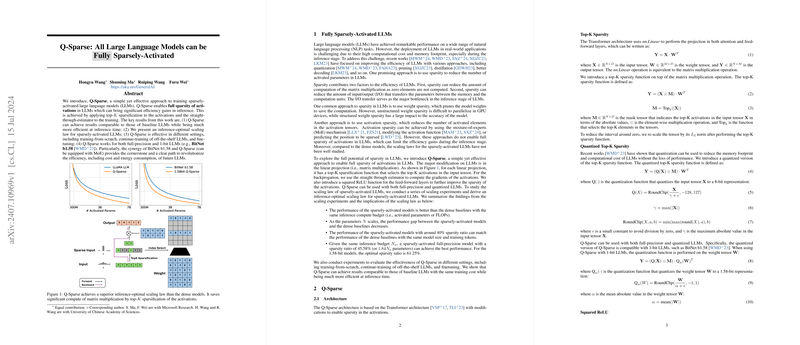An Analysis of "Q-Sparse: All LLMs can be Fully Sparsely-Activated"
The paper "Q-Sparse: All LLMs can be Fully Sparsely-Activated" presents a novel method for enhancing the efficiency of LLMs via sparse activation, called Q-Sparse. This approach targets a significant challenge in deploying LLMs in real-world applications: the high computational cost and memory footprint, particularly during the inference phase. The authors propose strategies for achieving full sparsity in LLM activations, which leads to both reduced computational demands and improved performance efficiency.
Key Contributions
The authors detail several specific contributions of the Q-Sparse method:
- Top-K Sparsification and Straight-Through Estimator (STE): The Q-Sparse framework applies top-K sparsification to activations coupled with the STE technique to maintain gradient flow during backpropagation. This combination is crucial for maintaining model performance while achieving sparsity.
- Sparsity in Various Settings: Q-Sparse demonstrates efficacy in training-from-scratch, continue-training of pre-trained models, and fine-tuning scenarios. The versatility across different training settings is a notable strength.
- Compatibility with Full-Precision and Quantized Models: The method supports both full-precision and 1-bit quantized models, the latter exemplified by BitNet b1.58. This extends the practical applicability of Q-Sparse to scenarios where memory and computational efficiency are paramount.
- Superior Inference-Optimal Scaling Law: The paper presents an inference-optimal scaling law for sparsely-activated models, showcasing a significant theoretical advancement. This scaling law indicates that sparsely-activated models can achieve better performance than their dense counterparts given the same computational budget.
Numerical Results and Findings
The experimental results substantiate the claims of Q-Sparse's efficiency:
- Performance-Compute Trade-off: With a sparsity ratio of approximately 40%, Q-Sparse models can match the performance of dense models while significantly reducing the number of activated parameters. For instance, a sparsity ratio of 45.58% yields an optimal performance with parameters (N being the number of parameters, a being activations).
- Training Effectiveness: Q-Sparse applied to both training-from-scratch and continue-training scenarios shows comparable performance to dense models with notable computational savings during inference.
- BitNet b1.58 Synergy: When Q-Sparse is combined with BitNet b1.58, the sparsely-activated 1-bit models retain high performance with even lower memory and compute footprints, revealing potential for further optimization in low-precision domains.
- Scaling Experiments: Various model sizes, such as 300M, 700M, and 7B parameters, confirm the scalability and consistent efficacy of Q-Sparse across a wide range of configurations. The findings suggest that as the model size increases, the performance gap between sparse and dense models narrows, validating the scaling laws proposed.
Practical and Theoretical Implications
Practically, Q-Sparse provides a clear pathway for scaling down the operational costs of deploying LLMs, making them more accessible for real-world applications where computational resources are constrained. Theoretical implications include a deeper understanding of scaling laws for sparse models, which could guide the development of future LLM architectures and inform best practices for utilizing sparsity.
Speculation on Future Developments
In terms of future advancements, extending Q-Sparse to integrate seamlessly with Mixture-of-Experts (MoE) architectures seems promising. Both approaches aim for sparsity but target different model components, suggesting a hybrid approach could yield even greater efficiency. Additionally, the paper hints at addressing non-batch-friendly aspects of Q-Sparse, indicating a direction for broader applicability in standard training and inference pipelines.
Conclusion
The paper "Q-Sparse: All LLMs can be Fully Sparsely-Activated" offers a sophisticated yet practical approach to reducing the computational footprint of LLMs while maintaining performance. By leveraging top-K sparsification and the STE method, Q-Sparse sets a new benchmark in sparse model efficiency. The detailed exploration of scaling laws and experimental validations positions this work as a significant contribution to the field, with practical ramifications for both academia and industry. Future work could expand on integrating Q-Sparse with other efficient modeling techniques and optimizing its implementation for batch-mode processing.
This sophisticated method represents an important step towards making LLMs more efficient and scalable, reinforcing the importance of sparsity as a key factor in the development and deployment of future AI systems.
